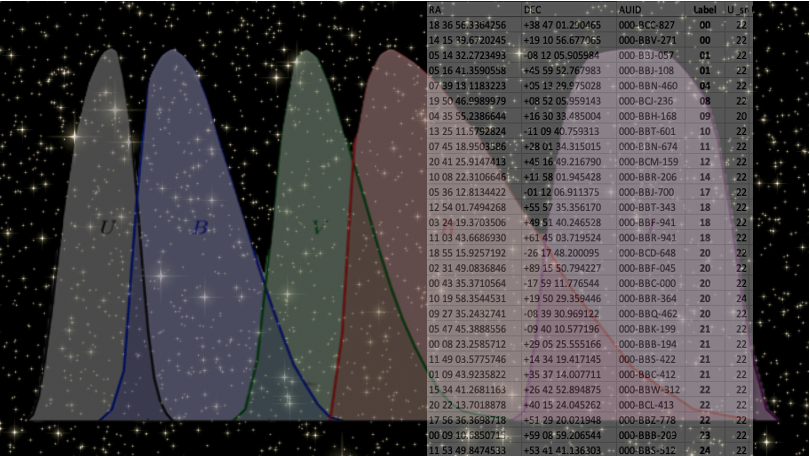
Inconsistencies in the WBVR catalog magnitudes adopted in the Variable Star Database were causing issues for our observers. A major clean-up was in order. | By Sebastián Otero & Tim Lyster
In 2008, during the early days of our Variable Star Database (VSD—which really should be called the Comparison Star Database!), we needed to populate the database with magnitudes for a large number of bright stars. In order to do that, different catalogs were selected according to several different criteria, in particular, the General Catalogue of Photometric Data (GCPD) was given a higher priority in the original selection, so most adopted values came from it.
In order to fill the missing values, a subset of the WBVR catalog was adopted.
The Catalogue of WBVR Magnitudes of Bright Northern Stars comprises mean V-magnitudes and W-B, B-V, and V-R color indices (in the WBVR system) for 13,586 objects—determined from observations gathered between January 1985 and October 1988 at the Sternberg Astronomical Institute near Alma-Ata, Kazakhstan.
In recent years, several observers, such as Luigi Pirozzi, and particularly Tom Calderwood, the head of AAVSO’s PEP Section, noted inconsistencies in magnitude values of bright comparison stars.When several reports started to show up, it became obvious that these were not random errors and we needed to investigate the issue.
Assessing the Problem
One author, Sebastián Otero, began to formally assess the problem in July 2023.
Former AAVSO Director Arne Henden provided the list of records originally imported in 2008, and George Silvis extracted all objects with WBVR data in VSD (3,461 stars). Surprisingly, there were a number of variable stars among them, so they had to be flagged as such—since they can’t be used as comparison stars! Their VSX data was retrieved to assess their amplitudes and check if they could still be useful as comparison stars in the case of visual observations.
Improved positions from the Hipparcos catalog were adopted for all the stars, and this process also allowed the detection of a number of objects with close companions, making them potentially risky as comparison stars, because—depending on the instrument used-—some observers might resolve them as separate objects while others might not.
This detective work was a good example of the challenges faced when working with catalog data. The source catalog may have problems (typos, table mismatches, duplicate entries, empty fields) and there may be additional errors introduced during the data import to a second database (in this case, VSD).
An accumulation of errors built on top of each other, and the fact that more updates were introduced to those records over the years previous to this finding, created a complex puzzle that required a solution.
What Caused the Discrepancies?
As this project continued, we realized that most of the detected discrepancies had been caused by the wrong implementation of transformations to the original data. WBVR magnitudes had to be transformed from the WBVR system to the Johnson-Cousins UBVRcIc system, but the V-R values we could find in VSD were V-R(Johnson), not V-Rc as was claimed. All U-B values had been wrongly computed, too. Furthermore, a third of the B-V values had been determined from W-Bw—instead of B-Vw—likely as a result of a wrong column selection.
Time to Clean Up!
So we went ahead and started to clean up this mess.
This work resulted in some very useful by-products, like the revision of information on 76 objects in VSX, in order to ensure that they could still be used as comparison stars for visual observations. This was especially important for red giants and Be stars, which use to show long term changes, so they may have small amplitudes on record but their true amplitudes may actually be larger.
We removed 106 comparison stars because of the above, as well as 39 double or multiple stars. Every data-quality check typically reveals other unanticipated problems, and this time was not the exception. We found some faint stars (the WBVR catalog is limited to around 10th magnitude) had been misidentified with nearby Mira variables that were indeed included in the WBVR catalog. Thus colors of these miras had been attributed to several of those stars.
Further checks revealed other isolated problems, like typos and inconsistencies between magnitudes. These inconsistencies were mostly due to the VSD Admin tool calculating the different magnitudes from color indexes.
Because magnitudes and colors lived together in the database, and data from different sources were mixed over the years following different updates, the result was a complex mess—requiring a great deal of effort to fix.
To prevent that issue from arising in the future, on October 24, 2023, SeqPlot (the tool used by the AAVSO Sequence Team to create sequences) was updated and the use of color indexes was deprecated.
Final Steps
We applied correct transformations from WBVR to UBVRc to the whole WBVR catalog and—after George made necessary improvements to the VSD Admin tool so it could support batch uploads—we finally uploaded a file with 2,845 lines of corrected magnitudes. It would have been impractical to apply these corrections individually.
The last step in this long journey was to test how results looked on the development server. This is critical, because if something goes wrong, corrections can be applied without affecting the live version of the public-facing databases. This process led to another round of minor bug fixes.
Project Completion
The project was successfully completed on October 10, 2023, with all corrected data uploaded to the live server.
We want to thank our observers for noticing this problem and letting us know about it.
If you find any problems with your charts or comparison star magnitudes, don’t hesitate to reach out to us, so we can fix them. Please use our CHET form. ![]()

